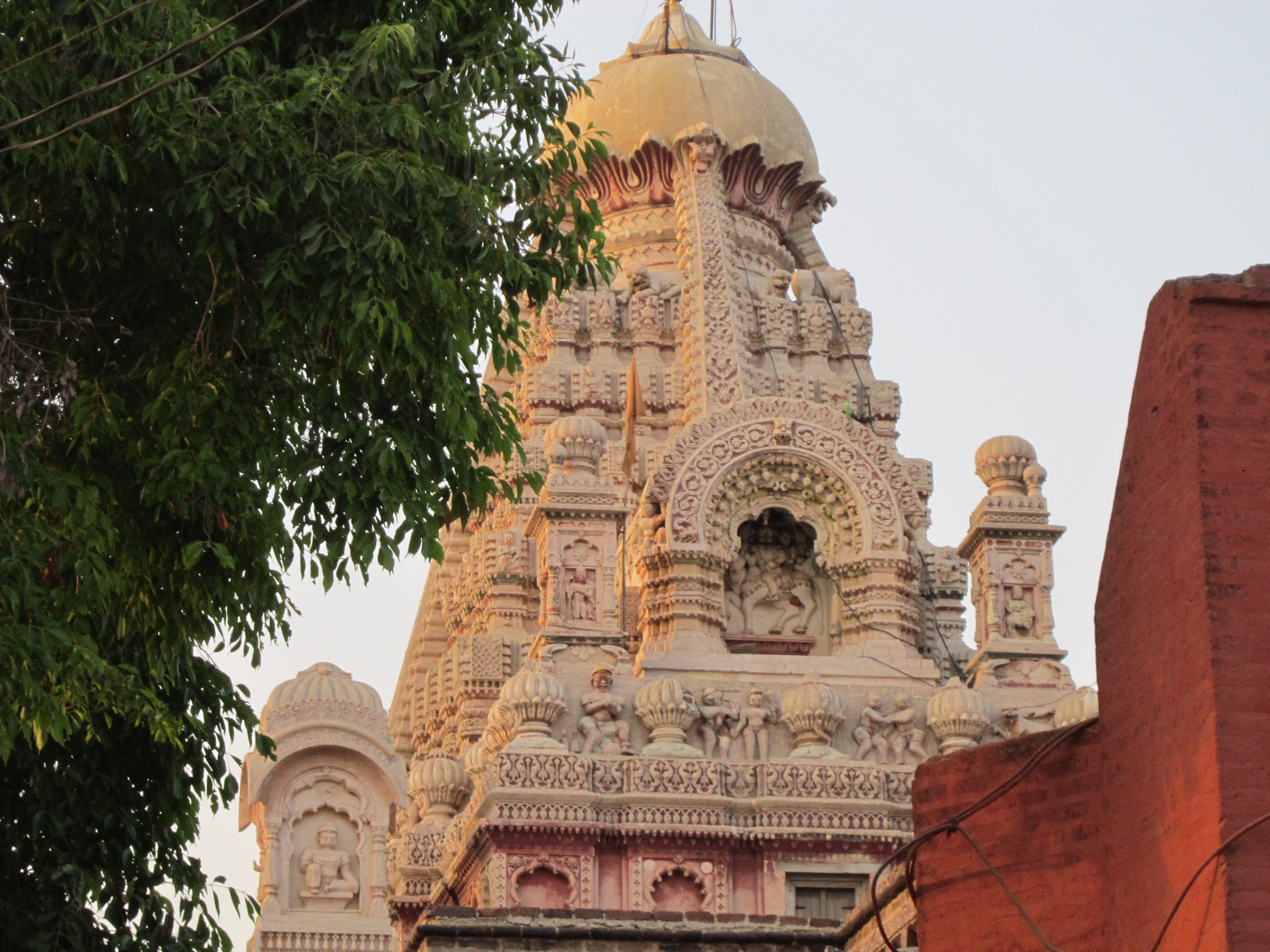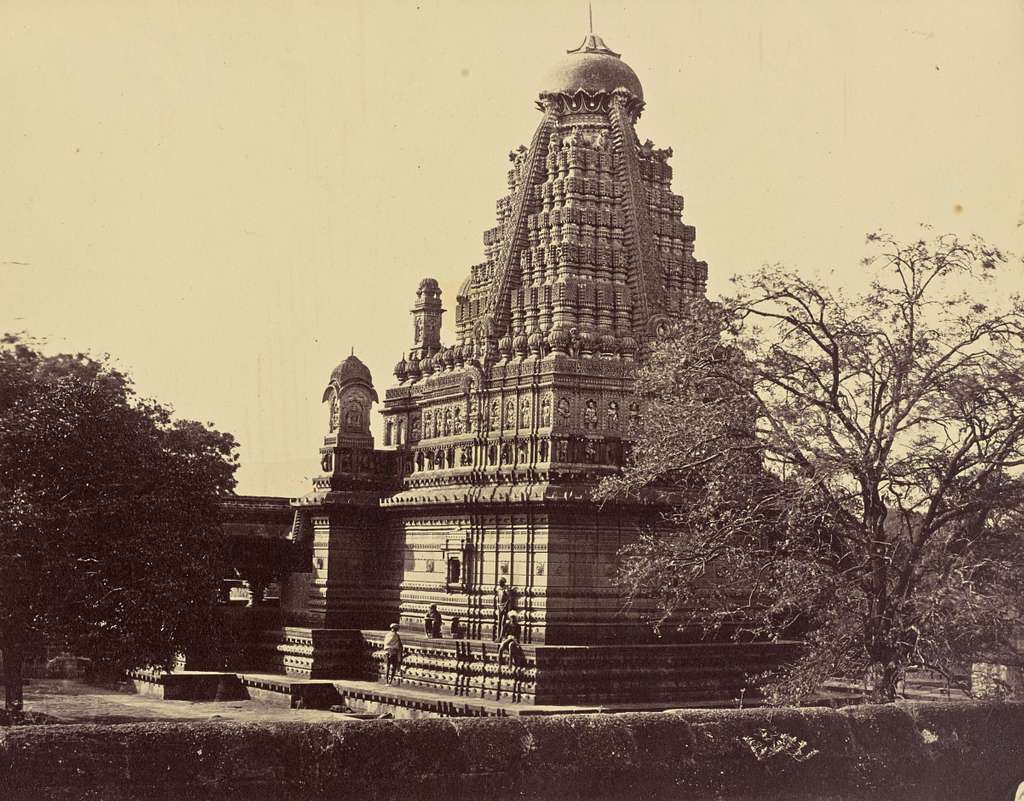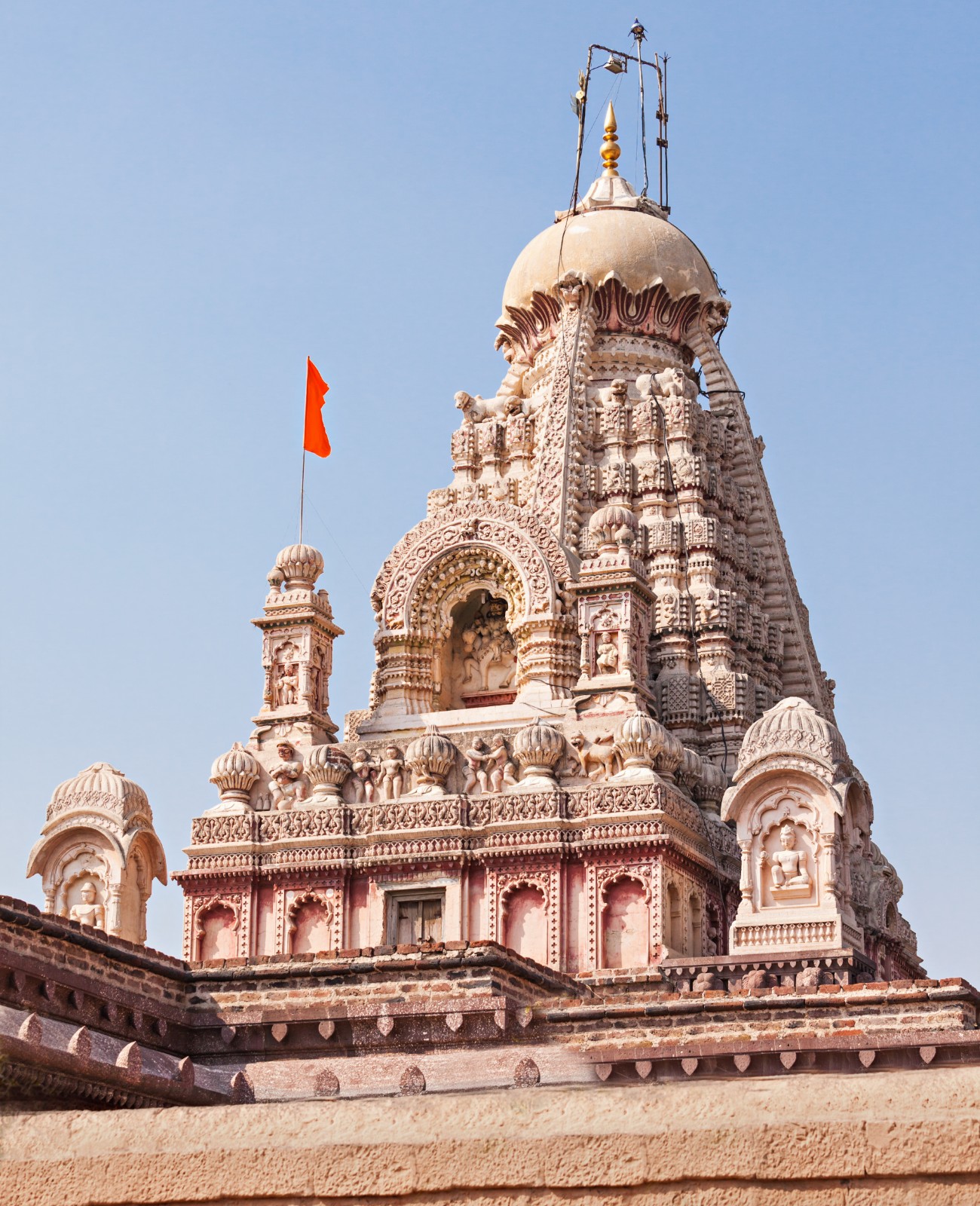Grishneshwar Temple, also known as the Grushneshwar Jyotirlinga Temple, is a famous Hindu temple located in the village of Verul, which is situated near Ellora in the state of Maharashtra, India. It is one of the 12 Jyotirlingas (sacred shrines of Lord Shiva) and holds immense religious significance for Hindus. The temple is dedicated to Lord Shiva and is believed to be one of the holiest places for Shaivites, the followers of Lord Shiva.
Key features and information about Grishneshwar Temple:
Architecture: The temple’s architecture is in the Hemadpanthi style, which is characteristic of many temples in Maharashtra. It features intricately carved stone structures and sculptures that are a testament to the art and architecture of the Yadava dynasty.
Legend: According to Hindu mythology, the Grishneshwar Jyotirlinga was established by Lord Shiva himself. The legend goes that a devout woman named Kusuma performed intense penance and pleased Lord Shiva, who then appeared before her and built the temple with the name “Grishneshwar.”
Jyotirlinga: The main sanctum of the temple houses the lingam (an abstract representation of Lord Shiva) known as the Grishneshwar Jyotirlinga. This lingam is the focal point of worship and devotion in the temple.
Location: The temple is situated close to the Ellora Caves, which are a UNESCO World Heritage Site known for their ancient rock-cut cave temples. This makes Grishneshwar Temple a popular pilgrimage site for tourists and devotees alike.
Festivals: Maha Shivaratri is the most significant festival celebrated at Grishneshwar Temple. Thousands of devotees gather at the temple to offer their prayers and seek the blessings of Lord Shiva on this auspicious day.
Accessibility: The temple is easily accessible by road from various cities in Maharashtra, including Aurangabad, which is the nearest major city. The Aurangabad Airport and railway station are the primary transportation hubs for those traveling to the region.
Grishneshwar Temple is not only a place of religious importance but also a remarkable example of Indian temple architecture and culture. It draws visitors from all over the country who come to seek spiritual solace and witness the historical and architectural beauty of the temple.
Table of Content
History
Grishneshwar Temple, also known as the Grishneswara Jyotirlinga, is one of the 12 Jyotirlingas (sacred shrines of Lord Shiva) in India. It is located in the village of Verul in the state of Maharashtra, near the famous Ellora Caves and about 30 kilometers from the city of Aurangabad. The temple is dedicated to Lord Shiva and holds great religious significance for Hindus.
The history of the Grishneshwar Temple dates back to ancient times, and it is believed to have been constructed in the 18th century by Queen Ahilyabai Holkar of the Holkar dynasty. However, there is a rich mythology and legend associated with this temple as well.
One of the most popular stories related to the temple revolves around a devout woman named Kusuma. According to the legend, Kusuma was the daughter of a Brahmin priest and was married to a cruel man who constantly taunted her for her devotion to Lord Shiva. Despite the adversities, Kusuma remained steadfast in her worship and would regularly offer puja to a Shivalinga she had fashioned from sand.
Impressed by her unwavering devotion, Lord Shiva decided to reveal himself to her and appeared in the form of the Jyotirlinga at Grishneshwar. It is said that the Shivalinga at Grishneshwar Temple is Swayambhu, meaning it is self-manifested and not sculpted by human hands.
Over the centuries, the temple has undergone several renovations and reconstructions. It features classic Hemadpanti architectural style, characterized by intricately carved stone walls and pillars. The temple complex also includes a large courtyard with a Shiva shrine, and it attracts thousands of pilgrims and tourists annually.
Grishneshwar Temple holds significance not only for its religious and architectural value but also for its association with the cultural and historical heritage of the region. It remains a prominent pilgrimage site for devotees of Lord Shiva, and it is an integral part of the Jyotirlinga circuit in India, drawing devotees from all over the country to seek the blessings of Lord Shiva.
Yearly Festivals
Grishneshwar Temple is one of the 12 Jyotirlingas, which are considered to be the holiest of Lord Shiva temples. The temple is located near Ellora Caves in the state of Maharashtra, India. While the temple is open throughout the year for regular worship and pilgrims, there are a few special festivals and events that are celebrated at the Grishneshwar Temple:
- Maha Shivaratri: This is one of the most significant festivals celebrated at Grishneshwar Temple and all other Shiva temples across India. It usually falls in the month of February or March. Devotees offer prayers, perform abhishekam (ritual bathing of the Shiva Linga), and participate in various religious activities to honor Lord Shiva.
- Shravan Month: The entire month of Shravan (usually in July-August) is dedicated to Lord Shiva, and Grishneshwar Temple sees an influx of pilgrims during this period. Devotees visit the temple regularly to offer water from the holy Ganges to the Shiva Linga. Mondays of Shravan, known as Shravan Somvar, are considered especially auspicious for Shiva worship.
- Diwali: The festival of Diwali, which usually falls in October or November, is celebrated with enthusiasm at Grishneshwar Temple. The temple is adorned with lights and decorations, and special pujas are performed to seek the blessings of Lord Shiva.
- Kartik Purnima: Kartik Purnima, which falls in the month of Kartik (usually in November), is another important festival celebrated at the temple. Devotees gather to offer prayers and participate in various religious rituals on this auspicious day.
- Mahashivratri: Besides the major Maha Shivaratri festival, the temple also celebrates the local Mahashivratri with devotion and grandeur.
Apart from these festivals, the temple witnesses a continuous stream of devotees and visitors throughout the year. It’s important to note that festival dates may vary from year to year based on the Hindu lunar calendar, so it’s advisable to check the specific dates for these festivals each year if you plan to visit Grishneshwar Temple during these celebrations.
Daily Pujas
Grishneshwar Temple, also known as the Grishneshwar Jyotirlinga Temple, is one of the 12 Jyotirlinga shrines dedicated to Lord Shiva in India. The temple is located near Ellora Caves in the state of Maharashtra. Daily pujas and rituals are an essential part of the temple’s daily schedule. Here is a general outline of the daily pujas and rituals that take place at Grishneshwar Temple:
- Mangal Aarti: The day typically begins with the Mangal Aarti, which is performed early in the morning to wake Lord Shiva. Devotees gather to witness this auspicious ritual.
- Abhishek: After the Mangal Aarti, the Shiva Linga is bathed with holy water, milk, and other sacred offerings in a ritual known as Abhishek. This ritual is believed to cleanse and purify the deity.
- Shringar Aarti: The Shringar Aarti is performed in the late morning or early afternoon, during which the deity is adorned with beautiful clothes and ornaments.
- Dhoop Aarti: In the evening, the Dhoop Aarti is performed. Incense sticks are lit, and devotees sing devotional songs in praise of Lord Shiva.
- Shej Aarti: The Shej Aarti marks the temple’s closing ritual, which takes place before the deity’s nighttime rest. It is performed with a sense of devotion and reverence.
These are the general daily pujas and rituals that occur at the Grishneshwar Temple. However, the specific timings and details of these rituals may vary depending on the temple’s traditions and local customs. It’s always a good idea to check with the temple authorities or priests for the most up-to-date information if you plan to visit and participate in the pujas.
How To Reach
Grishneshwar Temple, also known as the Grishneshwar Jyotirlinga Temple, is a famous Hindu temple dedicated to Lord Shiva. It is located in the state of Maharashtra, India. To reach Grishneshwar Temple, you can follow these general directions:
- By Air: The nearest major airport to Grishneshwar Temple is the Aurangabad Airport (Chikkalthana Airport). It’s approximately 29 kilometers (about 18 miles) away from the temple. You can book a flight to Aurangabad Airport from major Indian cities like Mumbai, Delhi, and others.
- By Train: The nearest railway station to Grishneshwar Temple is the Aurangabad Railway Station. Aurangabad is well connected to major cities in India. Once you reach Aurangabad, you can hire a taxi or take a bus to reach the temple.
- By Road:
- From Aurangabad: Grishneshwar Temple is around 29 kilometers away from Aurangabad. You can hire a taxi or take a bus from Aurangabad to reach the temple.
- From Pune: If you are traveling from Pune, it is approximately 240 kilometers away. You can drive to the temple or take a bus.
- From Mumbai: Grishneshwar Temple is about 380 kilometers from Mumbai. You can take a train or bus from Mumbai to Aurangabad and then proceed to the temple.
- Local Transportation: Once you reach the vicinity of Grishneshwar Temple, you can hire a taxi or an auto-rickshaw to get to the temple complex. It’s a short drive from the main road to the temple.
Please check the latest transportation options and local guidelines before planning your visit, as they may change over time. It’s also a good idea to confirm the temple’s opening hours and any specific rituals or ceremonies if you plan to participate.
Where To Stay
Grishneshwar Temple is located in the village of Verul in the Indian state of Maharashtra. The temple is one of the 12 Jyotirlingas, which are considered sacred in Hinduism. If you’re planning to visit Grishneshwar Temple and are looking for places to stay, you have a few options:
- Verul: The closest place to stay near Grishneshwar Temple is the village of Verul itself. There are some budget and mid-range hotels and guesthouses available in this village, which is just a short distance from the temple. Staying in Verul is convenient if you want to be close to the temple.
- Ellora: Ellora Caves, a UNESCO World Heritage site, are also nearby. Ellora has a wider range of accommodation options, including hotels and resorts, and it’s not far from Grishneshwar Temple. Staying in Ellora allows you to explore both the temple and the ancient caves.
- Aurangabad: The city of Aurangabad, located approximately 30 kilometers (18 miles) from Grishneshwar Temple, offers a wider range of accommodation options, from budget hotels to luxury hotels. Aurangabad is a popular base for tourists exploring the Ajanta and Ellora Caves, and you can easily visit Grishneshwar Temple as a day trip from here.
- Shirdi: Shirdi, another famous religious destination in Maharashtra known for the Sai Baba Temple, is about 100 kilometers (62 miles) from Grishneshwar Temple. If you plan to visit both temples, you can stay in Shirdi, where you’ll find numerous hotels and lodges.
- Online Booking: You can also use online travel websites and hotel booking platforms to find accommodations in the vicinity of Grishneshwar Temple. These platforms provide a wide range of options, allowing you to choose a place that suits your budget and preferences.
Remember to book your accommodation in advance, especially if you plan to visit during peak tourist seasons, as it can get crowded. Additionally, check for guest reviews and ratings to ensure a comfortable and pleasant stay during your visit to Grishneshwar Temple.




